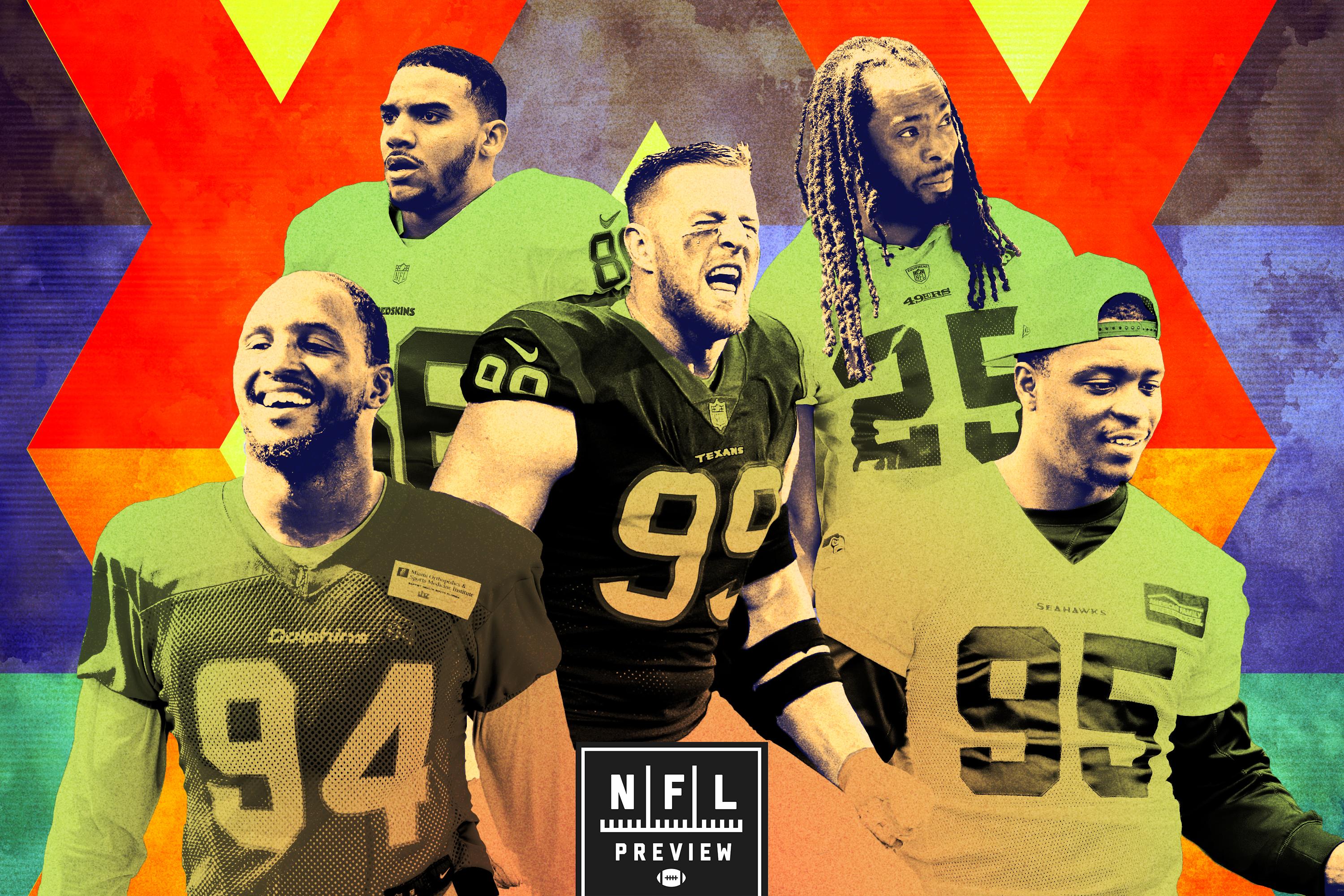
Every NFL team has its cadre of star players and dependable starters—a group of guys who coaches and fans can rely on to lead the team week in and week out. Every team has an X factor player or two as well: These are the wild cards, the unknowns, the players who carry with them the potential to be the catalyst that puts their team over the top—or be just another guy standing on the sideline. Taking quarterbacks out of the equation—that position deserves a category for itself—here’s every team’s top X factor heading into the season.
AFC East
Buffalo Bills: CB Vontae Davis
The backbone of the Bills’ defense last year was its ball-hawking back-end, but with the departures of E.J. Gaines and Shareece Wright, the no. 2 cornerback spot opposite Tre’Davious White is up for grabs. Davis, who signed to a one-year, $5 million deal in February, is expected to be that guy, but it’s been two years since the former Colts playmaker has looked anything like an elite cover corner—and the 30-year-old vet must prove he’s fully healthy after losing most of last year to a groin injury. If Davis can get back to his Pro Bowl form, though, Buffalo has the chance to field one of the top secondaries in the league.
Miami Dolphins: DE Robert Quinn
Quinn’s 19-sack campaign from 2013 feels like a distant memory, and the former Ram has suffered through a series of injuries and lackluster performances in the four years since. But a change of scenery could be what the eighth-year pro needs to revive his stalled career. Oh, and a change in scheme—he’s transitioning back to rushing with his hand in the dirt in Miami’s 4-3 defense—can’t hurt, either. Still just 28 years old, Quinn has the skill set to post double-digit sacks, and if he can stay healthy and get back to the dominant form we saw early in his career, it’d be a major boon for the Dolphins’ defense.
New England Patriots: WR Phillip Dorsett
With Brandin Cooks and Danny Amendola both gone and Julian Edelman set to serve a four-game suspension for violating the league’s PED policy, someone’s going to have to step up from the Patriots’ pass-catching group. Dorsett’s got plenty of competition, but a move inside to the slot could not only help the former first-rounder secure himself a role on the team, but also be the catalyst for a breakout year. The former Colt is mostly known for his deep speed, but he’s plenty agile—he ran a 6.7 3-cone at the combine—and spent time working with Edelman last week on the pivot and whip routes that Tom Brady loves to target over the middle. Dorsett can still utilize that deep speed on vertical routes from the slot, too, and after a full offseason immersing himself in the team’s playbook, has a shot to develop into a go-to guy in New England’s offense.
New York Jets: WR Terrelle Pryor
After making the switch from quarterback to receiver and catching 77 passes for 1,007 yards and four scores for the Browns in 2016, Pryor looked like an ascending talent who was only scratching the surface of his potential. But after struggling through injuries and failing to develop much chemistry with Kirk Cousins in Washington last year, he heads into 2018 at another career crossroads. Offseason ankle surgery has limited what he can do early on in training camp, but Pryor’s still got a scintillating combination of size and speed, and if he can stay healthy and build some rapport with the team’s starting signal-caller (whomever that ends up being), he could provide the spark this offense needs.
AFC North
Baltimore Ravens: WR John Brown
Brown looked like a breakout star back in 2015 when he caught 65 passes for 1,003 yards and seven touchdowns, but as he battled issues related to the sickle cell trait and a cyst on his spine, the former Cardinal saw his performance drop off dramatically over the last two years. Now a Raven, and reportedly feeling 100 percent, he’s drawn rave reviews in training camp and has developed chemistry with presumptive starter Joe Flacco. The deep ball’s been missing from Flacco’s arsenal the past few years, but a healthy Brown offers just the type of rare speed down the field that could help the veteran QB recapture it.
Cincinnati Bengals: WR John Ross
Ross had a nightmare rookie campaign, fumbling his first and only touch before being benched and subsequently placed on injured reserve—but the former ninth overall pick looks poised to break out in his sophomore year. Ross has already been lighting up Bengals training camp, showing off that 4.22 40 speed and some nifty route running. For a team that relied a little too heavily on superstar receiver A.J. Green, the immense potential Ross brings to the passing game as a field-stretching playmaker and third-down target underneath could be a major boon to quarterback Andy Dalton.
Cleveland Browns: WR Josh Gordon
Early in his career, Gordon emerged as an elite home-run-hitting mismatch creator in the mold of Randy Moss. But the Browns playmaker has missed most of the past four seasons fighting a well-documented battle with addiction—and voluntarily skipped the start of camp to seek counseling for the anxiety that has contributed to his past dependency on marijuana and alcohol. That decision demonstrates maturity and an understanding of what’s really important, but casts some doubt on his season. If Gordon can get to the point where he’s ready to return to the team, though, he could be that field-tilting game-changer we saw from a few years back.
Pittsburgh Steelers: S Terrell Edmunds
The Steelers revamped their subpar safety position over the offseason, signing Morgan Burnett and Nat Berhe in free agency while selecting Edmunds with the 28th overall pick of the draft (Sean Davis is the only major contributor that returns at the position). Burnett and Davis look like the likely starters at that spot, but Edmunds has already gotten some first-team snaps in OTAs and training camp and could earn a rotational role early on. The speedy former Hokie could make a difference at linebacker, too; he got snaps there during OTAs, and it’s a spot where Edmunds’s range could be put to good use. The rookie is still raw, but if he can prove over the next month that he’s got the instincts and discipline to play early on, he’d help fill two huge spots of need for Pittsburgh’s defense.
AFC South
Houston Texans: DL J.J. Watt
This one’s easy: A healthy, fully functional Watt is a world destroyer on a level rarely seen. The three-time Defensive Player of the Year hasn’t been himself over the past two seasons, though, as he’s been slowed by a series of debilitating injuries, and must prove that he’s not only back to 100 percent, but that he can still be the unblockable player he was earlier in his career. If Watt gets back to being Watt, the Texans defense has elite potential.
Indianapolis Colts: TE Eric Ebron
Ebron never lived up to his billing as the 10th overall pick in the 2014 draft in Detroit, and developed a reputation for drops along the way. But the 25-year-old tight end quietly produced solid numbers late last year; from Week 10 on, he reeled in 35 passes (tied with Rob Gronkowski for second among all tight ends in that stretch) for 379 yards (fourth) and three scores (tied for fourth). If Ebron can build on that strong finish, cut down on drops, and play with consistency, he’s got a real shot at finally breaking out. That’d be a major boost for a shallow Colts pass-catching corps.
Jacksonville Jaguars: TE Austin Seferian-Jenkins
Seferian-Jenkins revived his career in New York last year, but was mostly utilized as a security blanket underneath for Jets quarterback Josh McCown, catching 50 passes for 357 yards and three scores. That 7.1-yards-per-catch average belied his true value as a downfield threat, though, and the Jags could unleash Seferian-Jenkins thanks to their use of play-action passing. (McCown threw off play-action on just 13.0 percent of his snaps last year—28th out of 29 qualifying passers, per Pro Football Focus—while Jacksonville QB Blake Bortles ran play-action on 23.4 percent of plays [11th]. That number jumped to 41.8 in the playoffs.) Boasting a combination of size and speed, Seferian-Jenkins could be the perfect complement to the Jags’ fearsome ground game: a dynamic seam-stretcher to target on those play-action fakes.
Tennessee Titans: WR Corey Davis
Davis didn’t make much of an impact as a rookie, battling a nagging hamstring injury and a lack of chemistry with Marcus Mariota for most of the season en route to 34 catches for 375 yards and no scores. But the former fifth overall pick flashed elite potential late in the year, including a five-catch, two-touchdown performance in the team’s divisional-round loss to the Patriots. Davis has posted an uneven performance in the team’s training camp thus far—Malcolm Butler got the best of him on a few plays—but his rapport with Mariota has slowly grown. As Tennessee makes the transition from Mike Mularkey’s badly named Exotic Smashmouth system to Matt LaFleur’s wide-open Rams-style scheme, Davis could break out.
AFC West
Denver Broncos: S Su’a Cravens
After a bout with postconcussion symptoms and a year away from football (during which he considered retirement), Cravens will get a fresh start with the Broncos. The hybrid safety-linebacker is just the type of player Denver’s defense has missed since the Broncos released T.J. Ward in 2017: a strong tackler against the run, instinctive in coverage, and capable of playing multiple roles for what’s left of the team’s No Fly Zone crew. Cravens will need to prove he’s fully healthy and committed to playing football—and then carve out a role, whether that’s as a safety in the team’s big-nickel looks or at linebacker—but he’s got the talent to be a difference-maker for his new team.
Kansas City Chiefs: CB David Amerson
After trading away star corner Marcus Peters, the Chiefs need someone to step up—and in the early part of camp, it looks like the newly acquired Amerson could be the man for the job. But that’s no sure thing, as Amerson’s been anything but a model of consistency in his five-year career. The former second-rounder was released by the Redskins in 2015 after just two years with the team, then caught on in Oakland, where he played well enough to earn a four-year, $38 million extension in 2016. But Amerson failed to live up to that deal, posting atrocious numbers in 2017 (surrendering an opponent quarterback rating of 156.3, dead last among corners who played 25 percent of their team’s defensive snaps, per PFF) before being released in February. Now on a one-year, $2.25 million deal, he’s slated to start on the outside for Kansas City’s new-look defense. The way he plays could have massive implications for the Chiefs.
Los Angeles Chargers: S Derwin James
It’s always tough to expect much from a first-year safety. The game moves faster than in college, schemes can be more complex, and even the slightest mistakes can be exploited by the game’s elite signal-callers. Still, James has the versatile skill set to earn some snaps for the Chargers in the early going: Whether he’s patrolling the second level of the field to take away crossing routes, coming in on a blitz, playing the deep middle, or rushing off the edge (because why not?), James is a unique talent—and if he can earn a big role, he could take Gus Bradley’s defense to the next level.
Oakland Raiders: RB Doug Martin
When healthy, Martin has shown the ability to be one of the league’s most dynamic backs, an elusive home run hitter on the ground and dynamic threat in the passing game. But health has been elusive for the 29-year-old former Buccaneer, and we haven’t seen that version of Martin since 2015. Martin has drawn rave reviews from coaches and media alike in Raiders offseason practices this summer, though, and Jon Gruden looks determined to turn the Raiders into an old-school, smash-mouth team. If they can pair the Martin of old with Marshawn Lynch, that plan could actually work.
NFC East
Dallas Cowboys: DE Randy Gregory
After missing all of last year to suspension following a series of violations of the league’s substance-abuse policy, Gregory has been fully reinstated and looks ready to get his career back on track. The 2015 second-rounder has grabbed just one sack in 14 games, but still boasts the length and first-step explosiveness to develop into a productive pass-rusher. With David Irving set to miss the first four games to suspension and the team’s 2017 first-rounder, Taco Charlton, still developing, a Gregory breakout would be just what the Cowboys’ defense needs to contend in a tough NFC East.
New York Giants: CB Eli Apple
Apple’s tumultuous 2017 season came to an end when the Giants suspended the former 10th overall pick for the team’s final game after a series of run-ins with teammates and coaches. That might’ve signaled the end of Apple’s time with the team had New York not decided to clean house, and the guy who handed down that suspension, Ben McAdoo, along with former GM Jerry Reese, are all now gone. The talented but mercurial corner has a relatively clean slate with new GM Dave Gettleman and head coach Pat Shurmur, and the fact is, the team’s new regime badly needs Apple to break through. If Apple can put his troubles behind him and develop into a solid starter opposite Janoris Jenkins, it’d go a long way toward the Giants getting out of the cellar in the division.
Philadelphia Eagles: CB Sidney Jones
Super Bowl–winning teams always face the specter of a subsequent free-agent talent-drain, and the Eagles were not immune to that this offseason. The departure of veteran slot cornerback Patrick Robinson threatens to erode the defending champs’ efficiency and depth on the back end of their defense—but that problem could be mitigated (or eliminated altogether) with a breakout campaign from second-year corner Sidney Jones, a former second-rounder. Jones missed most of his rookie year with a torn Achilles tendon, but the former Husky’s been lighting it up at Philly’s training camp from both the outside and the slot. If he can emerge in 2018 as a playmaking cover corner, it’d be tough to see the Eagles skipping a beat on that side of the ball.
Washington Redskins: TE Jordan Reed
When healthy, Reed’s one of the most dynamic mismatch creators in the league—a move tight end in a similar mold as Travis Kelce, capable of stretching the seam, taking a screen pass and creating yards, or boxing out an opponent in the end zone. Reed’s career has been derailed by a series of injuries, but there’s little doubt that Jay Gruden’s will want to re-create the Alex Smith-to-Kelce connection with Smith and Reed in Washington this year. If he can stay on the field (Reed is reportedly feeling “100 times better” after missing most of last year to toe and hamstring injuries), he’ll bring a dynamic to the Redskins’ offense that has been sorely missing.
NFC North
Chicago Bears: OLB Aaron Lynch
The Bears have a more balanced and complete roster than you might think, but one area where they’re still dangerously thin is at edge rusher. Leonard Floyd’s the leader of the pack, but Chicago will be looking to the newly signed Lynch to take on a big role on the opposite side. The former Niner has never lacked talent or upside, but he’s been incredibly inconsistent in his four years in the league. Now reunited with Vic Fangio, Chicago’s banking on a big breakout from a guy who’s posted just 2.5 sacks in the past two years combined.
Detroit Lions: WR Kenny Golladay
In Golden Tate and Marvin Jones, Matt Stafford already has himself a dynamic duo to throw to down the field. But add in the potential for a breakout year for Golladay and Detroit looks primed to field one of the most dangerous and deep receiver groups in the league. The 6-foot-4, 213-pound pass-catcher boasts elite size, deep speed, and excellent body control, and started to showcase that intriguing skill set late last year, finishing with 28 catches for 477 yards and three scores at a jaw-dropping 17.0 yards per reception. He’ll need to build on that solid start—but offers immense upside.
Green Bay Packers: DE Muhammad Wilkerson
It wasn’t too long ago that Wilkerson was considered one of the most dominant 3-4 ends in the NFL. He racked up double-digit sacks and earned second-team All-Pro honors in both 2013 and 2015 for the Jets, but Wilkerson’s performance has dropped off the last two seasons—he’s totaled just eight sacks in that span. Now he’s in Green Bay on a one-year prove-it deal. He’s reportedly motivated for his fresh start, though, and a return to dominant form could give the Packers one of the most fearsome interior fronts in the league.
Minnesota Vikings: RB Dalvin Cook
Cook’s health is the real X factor here. He’s coming off a torn ACL, and it’s tough to know how quickly he’ll regain the explosiveness and cut-on-a-dime agility he showcased in a breakout performance for the Vikings last year. It’s promising that he was not only cleared for training camp, but is running without a brace—and head coach Mike Zimmer seems pretty excited about how his second-year back looks thus far. If Cook can get back to full speed by the time the season starts, Minnesota’s offense is going to be as balanced as any team in the league.
NFC South
Atlanta Falcons: RB Tevin Coleman
The Falcons offense was damn-near unstoppable in 2016, not just because of Matt Ryan and Julio Jones, but because of the way in which offensive coordinator Kyle Shanahan deployed his pair of dual-threat running backs, Devonta Freeman and Tevin Coleman. That duo created mismatch headaches for opposing defenses because of their ability to rush out of the backfield or run routes with equal aplomb. Freeman and Coleman combined for 2,482 yards and 24 touchdowns on land and through the air, but last year under new offensive coordinator Steve Sarkisian, the dynamic changed, and neither player was utilized in the passing game quite as effectively. This year, Sark’s installed new wrinkles in the scheme and the plan is to use both backs on the field together more frequently, getting Coleman more involved as a pass-catcher out of the backfield and on the wing. Defenses must decide how to match up with an offense that can run or pass from this set, and Coleman’s versatility as both a runner and receiver could be the key to a bounce-back year for that group.
Carolina Panthers: OT Matt Kalil
The Panthers’ decision to give the oft-injured Kalil a five-year, $56 million contract (that included $31 million in guarantees) never looked super prescient, so it was no surprise when the former Viking struggled with his new team last year, surrendering 44 pressures and six sacks on the season. Carolina’s now stuck with Kalil’s deal—he carries a $20.6 million dead-cap hit into 2018, meaning he’s basically uncuttable—leaving the team banking on a big jump from the veteran left tackle in 2018. That’s not necessarily out of the realm of possibility; Kalil was a Pro Bowler as a rookie and injuries have played a big part in his struggles, including last year when he was slow to recover from hip surgery. Now healthy for the first time in years, even an average performance from Kalil could be a major boon for quarterback Cam Newton.
New Orleans Saints: CB Patrick Robinson
Robinson resuscitated his career in Philly last year, emerging (on a miniscule one-year, $1 million deal) as one of the best slot corners in the league and a key component for the Super Bowl champs. Now returning to the team that originally drafted him, he’ll have to prove that last season—when he picked off four passes and allowed a passer rating of just 70.1 (fourth) in coverage, per PFF—was no fluke. If he can play like that, he has the potential to be the capstone piece that completes one of the league’s best secondaries.
Tampa Bay Buccaneers: DE Noah Spence
In 2017, the Bucs finished dead last in sacks (22), sack rate (3.9 percent), and pressure rate (24.8 percent), and tied for 27th in quarterback hits (74). They desperately need a pass rush and acquired Jason Pierre-Paul and Vinny Curry over the offseason to help provide it. Both veterans provide a net talent upgrade over what the team had last year, but if Spence (who grabbed 5.5 sacks and 28 hurries as a rookie but missed most of last year) can finally break out as an elite edge rusher, Tampa Bay could make a big jump on defense.
NFC West
Arizona Cardinals: OT D.J. Humphries
Talent’s never been a question with Humphries—a 6-foot-5, 307-pound tackle with smooth athleticism and plenty of length—and when he’s been on the field, he’s flashed promise. But a series of knee injuries and a concussion over the past two years has stifled the former Gator’s development and caused him to miss a total of 14 games. Now fully healthy, the Cardinals need Humphries to not just play a full season, but prove he can be a top-tier tackle in this league. Whoever lines up under center for Arizona, be it Sam Bradford or Josh Rosen, is going to need him to perform.
Los Angeles Rams: OLB Samson Ebukam
By pairing Ndamukong Suh with Aaron Donald, the Rams have assembled perhaps the most terrifying interior pass-rush duo in league history. Their edge-rushing group, though, is something else entirely, and with the departures of Quinn and outside linebacker Connor Barwin, L.A.’s going to need someone to step up. Ebukam is the proverbial next man up; The 6-foot-3, 245-pound pass rusher grabbed two sacks and a forced fumble in a rotational role as a rookie last year and is now poised to grab a starting job. The former Eastern Washington standout boasts intriguing athleticism—he ran a 4.5 40-yard dash and jumped 39 inches in the vert at his pro day last year—and, playing alongside Suh and Donald, should benefit from plenty of one-on-one rush opportunities.
San Francisco 49ers: CB Richard Sherman
A healthy Sherman could be the catalyst the 49ers need for a big jump on defense—a shutdown cover corner who can be trusted out on an island and can change the way the whole scheme functions—but it’s hard to predict what they’ll get from the 30-year-old who’s coming off an Achilles tear. Prior to his injury, Sherman was still playing at a high level, but even the savviest corners need a baseline level of speed, and that injury can sap explosiveness. The fact he was cleared for training camp is encouraging, but if Sherman’s still a step or two slow by the time the regular season starts, it could spell trouble.
Seattle Seahawks: DE Dion Jordan
With Cliff Avril retired and Michael Bennett an Eagle, the Seahawks pass rush is going through a transition phase (and that’s a kind way of putting it). Frank Clark is expected to pick up much of the slack, but Seattle’s going to need big things from the former bust this year. Jordan flashed a lot of potential in the limited opportunities he got for Seattle last season, notching four sacks and 12 total pressures on just 61 pass-rushing snaps. That’s an exceedingly small sample size, but was good for a 17.5 pass rush productivity score, per Pro Football Focus, second among all 4-3 ends. If Jordan can get even close to matching that type of consistency over a full season, it’d pay huge dividends for the Seahawks’ new-look defense.


